|
Hiss? No, thanks
As you may know, there are four types of Dolby: B, C, S and HX Professional, widely known. there were also other noise reduction systems, like dbx, High Com or Adres but Dolby ones were, by far, the most widely available.
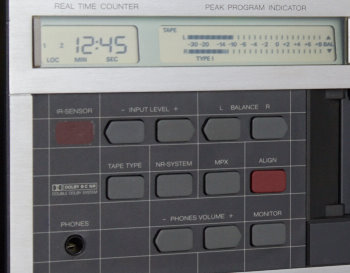
Dolby button in my Revox B215.
- Dolby B is the oldest and simplest. It can reduce the hiss about 9dB, which means will reduce it to 1/8 of the original level. One of the best advantages is that a tape recorded with Dolby B can be played without it and the result is acceptable. Many people like to play tapes this way, as it compensates the HF loss because of the differences in azimuth between decks, but that is not the way it should be played, as Dolby is not a EQ for raising the treble. Dolby B has a somewhat good compatibility between decks and walkmans. I recommend it if you want to play it with your walkmans AND you will be listening in a quiet environment or with a good isolating headphones. Otherwise, Dolby is not worth using, because you will not perceive the background hiss but you may perceive the HF loss.
- Dolby C is more advanced and only found in decks (it's very difficult to find it in boomboxes or walkmans). It combines the effect of two Dolby B together with an expansion of the lower frequencies. It can reduce the hiss by up to 15dB (which means a reduction to 1/30 of the original level). It’s very sensitive to slight differences in the way it works internally between decks and it can easily make the highs sound like cut when you play a tape recorded on another deck. I generally only recommend Dolby C if you want to play the tape in the very same deck on which you recorded it, to avoid compatibility problems.
- Dolby S is the most modern and advanced and it can improve the results of Dolby C, by reducing noise at up to 24dB. The drawback is that it sounds very bad when played without it. It is said that it is less sensitive to changes, making it more compatible.
- Dolby HX Professional is a special version that it’s not aimed to reduce the hiss. Rather than that, it slightly improves the high frequency response, and it does only work when recording and not when playing. It works by dynamically changing the bias during recording and the very same music. Many modern decks have it, even 2-head ones, but usually is activated all the time (remember that it only works when recording) and there’s no way to deactivate it. But there are a few ones that lets you manually set it on or off, like my SONY TC-K909ES. The difference between activating it or not is very small, though.
Many people knew an easy trick to recover some HF lost: to record with Dolby B and then play the tape without it. But this is really not as good trick as it looks, because what Dolby does when it encodes is not to equalize by pulling up the HF; it does a different thing. Reason why if you have encoded a tape with Dolby, you may play it with Dolby ON. If you experience problems with HF loss, dull or something similar, you may try any of these solutions:
- If you experience that problem in the very same deck where you recorded it, you may take it to adjust internal Dolby settings so it sounds transparent. If that deck has no adjustable Dolby settings inside, you may consider upgrading to a better one…
- If you are recording and playing with a walkman, consider using one of the best ones, like a WM-D6C, WM-D3 (with the center gear restored) or a small deck like the SONY TC-D5 or a Marantz PMD-430 (a properly restored one, of course). They have a very good quality Dolby ICs.
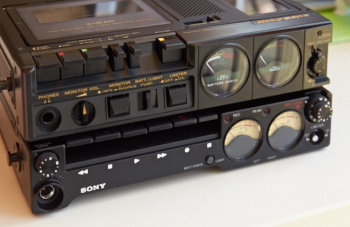
My SONY TC-D5 Pro II & Marantz PMD-430.
- If you recorded it with a good deck and you’re playing it with a walkman, you may be experiencing incompatibility problems between them. There’s no easy solution for this... one is to pick one of the best ones with Dolby out there, like the SONY DD, AIWA PX101/303/505/410 or the PC202. Another one is to take your deck to a [really good] technician and ask him to adjust the Dolby for your walkman (and cross your fingers). Another one is to get a D6C restored and tuned by Dr Walkman, as he really can adjust the internal Dolby of this wonderful portable recorder so it matches really well with most good walkmans, even with Dolby C.
- Another solution is to find a JVC NR-50, which is a noise reduction device that features Dolby as well as ANRS (the brand’s proprietary noise reduction) and it’s easily adjustable. But it’s really rare and difficult to find one.

My JVC NR-50, a rare noise reduction unit.
- Last but not least (an obvious one): forget using Dolby. If you are not listening in a quiet environment, you may not need Dolby, do you? Some audiophiles do prefer to record without it, even thou they have high-end gear, because they state that some details are lost and they prefer the purest response, without any audio filtering at all. I agree with that.
(Better) adjusting the rec level
In my previous guide I’ve already explained this matter, but the truth is that there were just the essential rules. Now I’ll explain a more advanced technique that will let you record at higher levels with lower distortion.
As I explained, you should set the rec level so you reach 0 VU mark and don’t let the level go further, but it’s not as simple… All tapes are not equal, and so are the recording levels for each. Usually type II tapes allow more or less the same recording levels than type I, and type IV allow for even higher levels than both them. But not all tapes are equal within every category: best ones can be recorded with higher levels.
But… which ones are good? Good question. Well, there are a lot of good tapes, mainly from well-known brands, like Fuji, BASF, That’s, Denon… but I must mention the best ones from TDK, SONY and Maxell. These are some good tapes that I know pretty well and are somewhat easy to find:
- Type I: TDK AR, SONY HF-S, Maxell UDI
- Type II: TDK SA | SONY UX-S | Maxell XL-II
- Type IV: TDK MA-R | SONY METAL-XR | Maxell MX-S
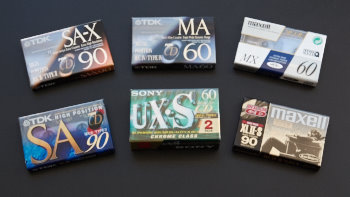
A bunch of excellent tapes.
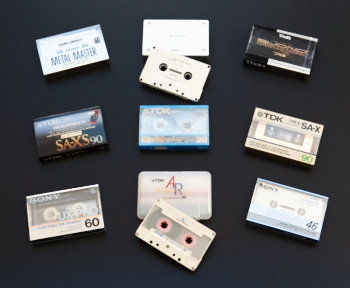
Some of my best tapes.
The difference between a budget and a good tape are the maximum recording level, the high frequency response and the background hiss. As a rule of thumb, with a good type I and II tapes you can reach higher recording levels (up to 4 VU) than with budget tapes. The main difference between type I and II is the treble headroom and [especially] the background hiss. Chrome tapes allow for much lower hiss, although good ferrics offer excellent bass response. With good metals, you can record up to 6 or 7. But be aware that this levels should only be kept for a few instants or audible distortions will appear. In other words: you may adjust the higher peaks and not the average loudness to this level.
Best ferric tapes can offer an unexpected quality, as they can reach almost the same maximum recording levels than the best metal tapes (up to 6-7 VU) but at the cost of a much higher hiss. Chrome tapes cannot reach those levels but offer better treble response than ferrics and much lower hiss, so they offer a good compromise between type I and IV.
Anyway, the mentioned maximum levels are just a brief recommendation, and you always have to trust your ears. What's best about using a 3-head deck is that you can record a few seconds and listen to hear the quality of the result. What I did (wrongly) many times when I began to research for the best recording techniques is to adjust the VU meters without paying attention to the result, without listening to the result, and it's definitely not a good idea. That way you can hear if there's distortion in the highs or whatever issue that can appear.
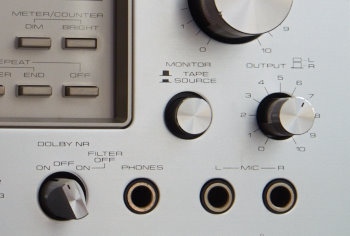
The monitor switch on 3-head decks, one of the most important tools for controlling the quality.
I'd like to add a few note about all that. As I axplained in my previous guide, the record level should be set so the peaks reach the maximum level, so everything is kept under a very low distortion. However, there are cases where you may adjust it a bit higher. With very high dynamic range music (like classical or soundtracks) you may record the peaks higher than you should (so they will distort a bit) to avoid hiss in the rest of the song, where the levels can be low or very low. In these cases, using a very good noise reduction is a must, like Dolby C, S or dbx. With it, you can keep the levels as explained before, so the distortion will be very low and the hiss too.
|
![]()
![]()
![]()
